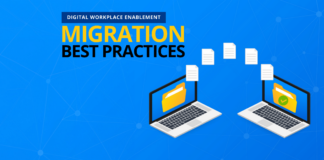From the moment that a company makes a business decision to no longer contribute to leases on large and expensive data centers, the plan to migrate and modernize begins. The process of exiting a data center is not one without challenges, however. Most companies require outside assistance from a service provider that specializes in cloud adoption.
Whether the company is going to take the route of using an external company or determines that they have the internal resources to undertake this task, there are still some things to consider to ensure that the migration is a success and that you come out of it ready to support the new cloud-only environment.
This article identifies five (5) common pitfalls that may impact your ability to migrate and support a cloud-only environment. These are:
- Technical and business drivers are misaligned
- Lack of planning and assessment of current environment
- Not taking advantage of cloud platforms and SaaS services
- Staff skillset to support
- User adoption and change management
Let’s take a deeper look at each one of these and how to avoid them from becoming a roadblock to your data center exit.

1. Technical and Business Drivers are Misaligned
This is a big one that could become a roadblock to both planning and success. If you’re reviewing and looking at business drivers for moving to cloud services, the number one driver that many cloud providers put on that list is “cost savings.” It’s an immediate red flag if the business stakeholders state that you are moving to the cloud to save money. Other reasons like the cost of real estate, soft cost savings, and the whole OpEx vs. CapEx benefit to moving to a cloud provider should generally be higher up on the list of reasons why cloud makes sense. Technical professionals that are given a project to move to a public cloud provider to save money should be concerned with the metrics and perception after this migration has taken place.
Technical stakeholders and business stakeholders should be meeting and discussing the overall goals of the business and how moving to the public cloud can assist in realizing those goals in an accelerated manner. For example, if the business has a goal to expand their current customer base beyond their current geographic reach, utilizing a public cloud provider such as AWS, Azure, or Google can enable this to happen faster than a business’ ability to build that capability with their own data centers. Having this alignment in the planning process can avoid a misalignment pitfall.
2. Lack of Planning and Assessment of Current Environment
You likely won’t be surprised that a lack of planning is common to many of these pitfalls, but the next is specifically about not properly understanding the current environment. Many on-premises data center infrastructures have been in place for years, perhaps decades, with applications that have been maintained on older hardware, operating systems, and databases. Properly assessing and understanding this environment and how that is going to impact the timing and architecture of the cloud environment needs to be planned for before initiating the migration to avoid downtime and additional costs associated with upgrades. The understanding of the current environment and how that’s going to be best optimized in the new cloud environment leads us to our next common pitfall.

3. Not Taking Advantage of Cloud Platforms and SAAS Services
There are many different drivers, both technical and business-related, that moving to a public cloud provider will provide. The ability to scale and expand quickly geographically is one of those. Another is the ability to re-factor existing applications, databases, and workloads for platform services (PaaS) and SaaS-based software solutions. Our current on-premises databases have applications and databases that are built on Windows and Linux operating systems. Administratively, we need to make sure that these operating systems are maintained at the currently supported version with all applicable updates and security patches to avoid potential vulnerabilities.
Public cloud providers have built platform services for web applications and databases that allow you to develop and maintain the application code without the concern for patching and updating the operating systems. The cloud provider maintains the most recent, stable operating system version so your infrastructure is never out of date. Utilizing SaaS solutions such as Office 365, SharePoint Online, or Google Suite allow you to avoid the need to maintain servers for these business applications. This also provides the flexibility of a pay-per-use model that can change as your user environment expands or decreases.
Many companies take a “lift and shift” approach of simply moving applications and databases in a like-for-like manner without taking advantage of these PaaS and SaaS capabilities. To avoid these common pitfalls, you should plan and assess the environment and determine where applications and databases would benefit from a re-factoring or re-platforming.
4. Staff Skillset to Support
Whereas the first three pitfalls were related to planning the migration and infrastructure of your new cloud environment, the last two are staff and personnel-related. The first of these is the skill set of your staff and any gaps that may be apparent in supporting a public cloud environment. If you’re going about the migration correctly and avoiding the previous three pitfalls—especially the use of PaaS and SaaS solutions—then the administration of the new cloud environment is going to be significantly different than the on-premises data center environment. Physical network and host servers will no longer play a significant role in your infrastructure, and how you manage identity and access with roles, policies, and permissions will be the first line of defense to the new cloud infrastructure.

Legacy network and server administrators may not have the skills to support this new environment. To avoid this pitfall, support staff should be trained and certified in these skills prior to executing the migration from the current environment to the cloud environment. Utilizing third-party service providers can also help to bridge the gap in skills.
5. User Adoption and Change Management
The final common pitfall is based on staff preparation for the upcoming changes. Proper planning and communication of what is taking place within the current environment and what the new cloud environment is going to look like is extremely important to avoid user confusion and potentially a lack of adoption. If you’re planning on moving to new cloud environments and immediately deprecating the existing on-premises environment, then users will be forced to adopt the new cloud environment. However, if communication of what this is going to look like is not handled in advance, users are going to flood the support desk with questions. A poor user adoption experience will reflect badly on the business’ view of a successful migration and the technical staff will have to absorb this negative feedback.
Summary
Overall, the ability to avoid these common pitfalls all align with proper planning and preparation up front. If you plan for the new environment, have open discussions with stakeholders at all levels, and architect the new environment to align with the goals of the business and the benefits of the cloud, you should have a successful migration. Good luck on your cloud-native journey.






